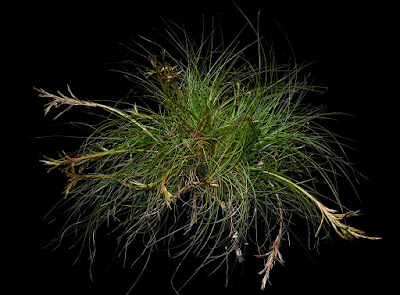Tillandsia festucoides is native to Central America, in an area covering Mexico, Cuba, Jamaica, the Dominican Republic and Puerto Rico. It is found at an altitude of up to a little over 1000 meters above sea level.
Tillandsia festucoides, also called as The fescue air plant, Tillandsia caricifolia, is a species of the genus Tillandsia. This species was described by Adolphe-Théodore Brongniart ex Carl Christian Mez in 1896.
IDENTIFY TILLANDSIA FESTUCOIDES AIR PLANT
Tillandsia festucoides is native to Central America, in an area covering Mexico, Cuba, Jamaica, the Dominican Republic and Puerto Rico. It is found at an altitude of up to a little over 1000 meters above sea level.
It is a medium to large sized epiphyte (up to 50 cm), acaule species with numerous, fine leaves in a tight and fasciculate rosette. The sheaths are triangular and brown, the limbs are linear, light green.
The fescue air plant bloom from the quite large (20 cm on average), slender, arranged on a fine peduncle, bipinnate, strongly digitate, pyramidal inflorescence with flattened, curved and flexuous spikes. The bracts of the flowering stem are upright, imbricate, filiform and red (especially at the level of the upper part of the inflorescence). The floral bracts are nested, hairless or scaly, veined, leathery, keeled and sometimes curved near the apex, green at the base and more or less red at the apex. The non-fragrant flowers are almost sessile, tubular, 2 to 3 cm long, purple color. The stamens and the pistil are exserts.
TILLANDSIA FESTUCOIDES AIR PLANT CARE AND CULTURE
Cultural information should only be used as a guide, and should be to be adapted to suit you. Your physical location; where you grow your plants, how much time you have to devote to their care, and many other factors, will need to be taken into account. Only then can you decide on the cultural methods that best suit you and your plants.
Light:
Tillandsia festucoides requires a good light without full sun. Be careful in winter to return the plant after watering to empty the water that sometimes accumulates in the heart of the plant (waterproof rosette) and thus avoid any risk of rot. Place the plant very close to a window in the winter and preferably out in mid-shade in the summer.
Temperature:
The required temperature ranging from 10 to 32°C. Get it early enough in the fall if you grow it outside, so that it does not face night temperatures below 4 or 5 ° C, especially if it is wet. The plants can faced temperatures close to 0 ° C (sheltered and dry) for a few hours without damage.
Humidity:
The fescue air plant need the moderate level of humidity. Good aeration is required, the plant must dry quickly (in less than an hour).
Substrate, growing media and repotting:
Tillandsia festucoides refer to be mounted on a solid substrate that does not retain water. You can glue the plant directly to the surface with a strong adhesive, or you can wire the plant to the base. Don't cover the base of the plant with moss or it may rot. It can be grown on almost any imaginable decorative mount, including shells, rocks, slate, driftwood, etc.
Watering:
Twice a week in summer, once a week in winter according to the luminosity and the ambient humidity. Obviously when it rains and if you grow it outside, it counts as a watering. Be sure to return the plant after watering to remove excess water.
Fertilizer:
This air plant can be fertilized with the moderate doses. 1 to 2 times a month in the summer and 1 time a month in the winter.















COMMENTS